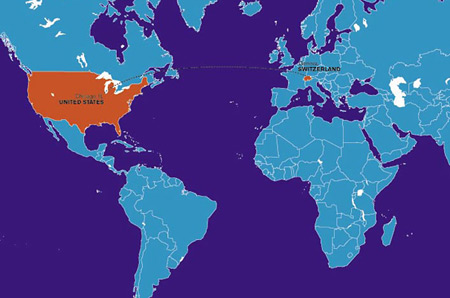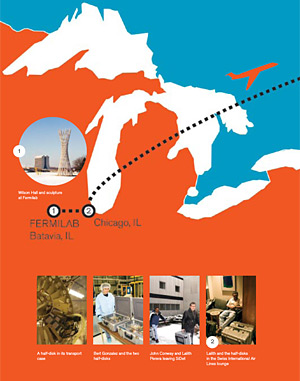Day in the life: Traveling detector
For million-dollar components that travel thousands of miles to become part of a particle detector, the most perilous part of the trip might be airport security.
By the time 2007 started, we had carefully plotted the best way to get 10 delicate pieces of equipment to Geneva, where they will sit at the heart of a 12,500-ton detector in the new Large Hadron Collider at CERN, the European particle physics facility.
We decided the do-it-yourself solution was cheapest and safest: We would carry them by hand on a commercial flight, two at a time, and put each one in its own passenger seat. But flying coach also poses risks, from jostling and bumping to condensation caused by abrupt temperature changes. The same kind of electrostatic discharge you get from rubbing your feet on the carpet and touching a door knob is enough to wipe out an instrument, and the belt that takes carry-ons through the X-ray machines is notorious for generating those charges. Then there are the rollers’ bump, bump, bump. We didn’t want that.
Clearly the security personnel needed to be able to inspect the devices without actually touching them. So we built a special acrylic box with an internal aluminum mount. This box nestled into a foam-lined, hard-shell case that could fit on an airline seat. Lalith Perera, a postdoc at the University of Iowa, would accompany me on this first run.
The devices in question, called Forward Pixel Half Disks, are the smallest and innermost of the detector elements in one of the LHC’s two giant detectors, the CMS Tracker. They’ll be the first ones hit by particles coming out of collisions. They’re quite light, less than a kilogram each, and covered with featherweight wafers of silicon.
The half-disks are designed to survive the intense radiation environment inside an operating collider. They are sturdy enough to survive a plane trip, but not to survive poking by your fingers. They have these extremely delicate, fine wires. As for the silicon wafers, imagine the thinnest glass you’ve ever encountered. I would say they’re about as robust as a potato chip. On the other hand, we’ve glued them to thin plates of beryllium, which are very light but mechanically strong, so they are unlikely to flex much.
The two disks we would deliver in January were prototypes for the collider’s initial engineering run this fall. But the next eight would be the real things, and much more expensive. It’s hard to put a price tag on these things, because they represent the labor of 100 people for 10 years. If they were lost or destroyed, we’d have to do everything again.
The original plan was to fly from Fermilab, where the devices were built, to Zurich; there we would go through customs and drive to Geneva. But the day before leaving, we discovered that in order to avoid paying import duty on the devices we would have to go through customs in Geneva, which has a special arrangement with CERN. So we would have to fly from Zurich to Geneva and risk getting hung up while changing planes.
After checking in at Chicago’s O’Hare Airport we called our Transportation Security Administration contact, Daryl Wilson. His supervisor guarded our cases while we took the rest of our bags through the normal process. Once on the secure side, we opened the cases and removed the acrylic boxes for inspection; meanwhile, the cases went through the X-ray machine. The security screeners swabbed for explosive residues and peppered us with questions: What the heck were these things? What was the experiment at CERN for? It clearly was a bit of excitement for them in an otherwise routine day.
Once on board, we tried to set the cases on the seats, but the flight attendant insisted that they had to go on the floor. So that is what we did, with some pillows for additional cushioning. The flight was uneventful, and Lalith and I managed to eat and sleep.
In fact, the only problem we encountered was at the Zurich airport. We showed up cold at security and had to explain the whole thing from the bottom up. At first they were adamant: We had to put the devices through the X-ray machine. We smiled politely and asked to see the supervisor, who was nice and cordial and also said no. We took one of the detectors out of its acrylic case and showed him just how delicate it was. At that point he relented.
In Geneva we were met at customs by a CERN person who, thanks to advance work by our postdoc, Ricardo Vasquez, had exactly the right papers to zip us straight through. We got our rental car and got ourselves to CERN.
Like most labs at CERN, the CMS Tracker Integration Facility is housed in a nondescript industrial building. A team of postdocs has been working since December in our assigned clean room, bringing up the electronics systems needed to test the detectors after they are reassembled.
We just learned in the last week or so that the devices are working, so that’s a huge relief. The guys at the integration facility have done a great job and are eager for more.
We’ve spent a lot of time lately thinking about how to get the half-disks into the detector. It’s not like we can plunk them in. It’s a ship-in-a-bottle problem. The half-disks go in on rails. You have to synchronize the two halves and mesh them together once they’re in. We have a lot of work to do on this.
Four more shipments to go!
Story by John Conway as told to Glennda Chui
Click here to download the pdf version of this article.









